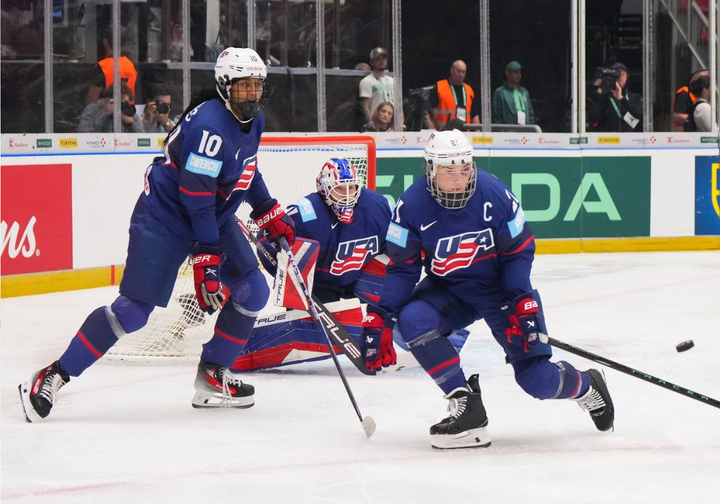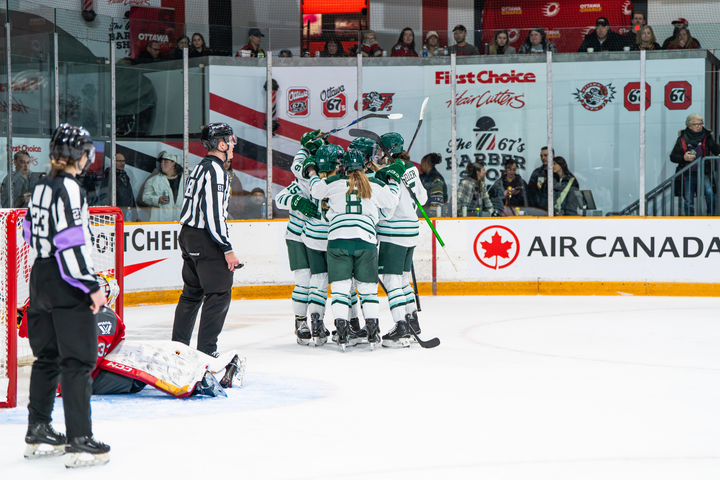Goalie to Goalie: An Interview with Ohio State’s Kassidy Sauvé
After nearly two years, the Buckeyes’ goaltender speaks about her long journey back to hockey
Yesterday, I wrote about the incredible return of Ohio State goaltender Kassidy Sauvé. After injuries that made her spend nearly two years away from the game she loves, Sauvé is now back on top of the NCAA. Hers is a story that I loved for a number of reasons, not just because we are both goalies from the same part of the Greater Toronto Area, though that helped. She overcame the type of adversity that no athlete wants to face, and many never recover from.
I had the opportunity to touch base with Kassidy this week and after speaking with her, I couldn’t help but be moved by her outlook on hockey and its place in her life.
Here is Kassidy’s story in her own words:
TH: As you grew up, were there any goalies you specifically based your playing style around?
KS: Growing up, I had quite a few hockey role models. Early on, when I was a very young goaltender, I loved to watch Ed Belfour during his time with the Toronto Maple Leafs. I’d watch him play and mirrored his style as best I could. He was more of a hybrid, standup goalie and I really liked that about him. He also played with an edge, which might also explain my connection to his style.
TH: Did you have any other hockey role models?
KS: At a young age, I got to meet Charline Labonté and I quickly became a huge fan. She soon became the goaltender that I modeled my game after. Since my first meeting with Charline, I have been privileged to meet with her on several occasions and she has become a confidant, friend and mentor for me. Not only is she an amazing goaltender, but she is also a pretty special person. I have always tried to wear #32 since I was very young because of Charline. Like myself, she played boys hockey for a long time and I feel like this is something we have in common and her feedback and suggestions have helped me develop. She has also been a good listener when I was going through my injuries and was always there to help me stay positive.
TH: Do you have a personal goalie coach that helped you create and grow your style?
KS: My personal goalie coach is Sandy Sampson. I have worked with him since I made the switch to women’s hockey in 2012. I really did struggle when I made the switch and was desperate to fix my game. We met with Sandy and he was quick to identify what needed to change in my game in order to excel in the women’s game.
In order to be successful, I really had to make a major change to my style of play. The women’s game is very different, a much more patient and some would say skillful game than the men’s game. Some of the things I was doing to be successful in men’s hockey made me unsuccessful in the women’s game. Sandy always insisted that I resort to my abilities to make the big save as a last resort but that I really had to calm my game down.
Some of the main adjustments that Sandy brought to my game that helped me achieve success quickly were being more technically sound, managing my rebounds to the quiet zones, being more patient on cross-ice activity, changing my glove angle and avoiding unnecessary rebounds. Being more poised in the net was more about maintaining a constant degree of focus. I owe a lot to Sandy and give him a lot of the credit for helping with my transition to the goalie I am today.
TH: Is your style any different now than it was before the injuries?
KS: Since my double hip surgery, I have had to change some aspects of my game tremendously. Prior to the surgeries, I really had no restrictions on my save selection, that is, until my hips started to hurt during my first season with the Buckeyes. By default, the pain I played with made me change my style. In all honesty, the injuries were a blessing in disguise for me because as a result, it has essentially forced me to further develop my technical game and not just rely on my athletic ability.
My post-to-post work has changed completely. I have incorporated the RVH technique which has been terrific and reduced the wear and tear on my hips considerably. I have also made a huge effort to read the play better. If I know where the puck is at all times and even more important, know where it is going, the pressure and exertion on my movements is managed and the potential for injury is greatly reduced. Also, I have always been more of a hybrid goaltender but now focus a lot more on the shot and try to not make any unnecessary movements. I now play every game with a smile and enjoy every minute of it. Sitting out for a year not only made me a different goalie but also made me appreciate what I have at OSU and how lucky I am to be able to attend a world class institution while getting a chance to play the game I love so much again!
TH: Speaking of your return from those injuries, how did it feel getting ready and taking warmup in that first game back?
KS: As composed as I may have looked on the outside, I was about ready to jump out of my equipment in my first game back. I was full of emotion; anxious, relieved, from smiles to tears. A special moment that may have gone unnoticed for many was to hear the playing of both the Canadian and American national anthems.
We were playing at RPI (in Troy, NY) and they played both anthems. It was special to hear my country’s national anthem in my first game back while also hearing the anthem of the country that I now represent through my school.
Another thing that filled me with emotion was seeing my mom and dad in the stands. This process was just as hard on them because they had to deal with the “No Hockey Kassidy” and for them to see me in my happy place again was such a thrill and a major relief. Something I have learned through this whole process is to never take any moment for granted and to enjoy the moment because you never know when it could be your last game. I think having hockey taken away from me for 581 days was the best thing that could have ever happened.
As a high-performance athlete, you are never given the opportunity to miss the game, it just becomes habitual to play it. I was given the chance to miss it and did I ever miss it.
TH: Did you ever get discouraged by the injuries? Was there a time that you thought you might not get back to being the player you once were?
KS: I most definitely got discouraged with my injuries. The first surgery, I could handle. I thought I might not perform as I used to but at the very least I won’t be in pain. My parents continued to be positive, often sending me stories of goaltenders who had similar injuries and made successful returns. They also made sure that I always had the right professionals working with me. The fear of the unknown most definitely consumed me from time to time.
During rehab and not long after I started wearing my equipment again, I started feeling pain in my other hip and not long after it was determined that I required surgery on my right hip. Depressed and frustrated can only describe how I felt. Deep down there were many times where I doubted I would be able to make a successful return. I thought of all the negatives, even my surgeon, who was absolutely amazing told me that I could expect a clean recovery, however there was always a possibility that I would be at 60-80% of what I was before. That was not going to happen so from that point on I was determined to make a full recovery and work diligently to get there. I had the second surgery, missed my entire sophomore season and the rest is history.
TH: How do you feel with a bunch of games under your belt, knowing the time off and hard work paid off?
KS: I owe my ability to play again to everyone in the process: my coaches, teammates, surgeon, physical therapist, strength coach and my family. When I doubted myself, not one of them did. They pushed me to properly embrace my time off and to train hard when I was cleared to do so in order to make a successful comeback. My parents sacrificed a lot this past summer to provide me with the best resources to make a full recovery. Once I got into summer training and I was pain free, my mood changed tremendously and my entire outlook around the process changed. I now knew I would make a comeback.
TH: Do you have any specific goals for the 2016/17 OSU Buckeyes? Any longer-term goals for your career?
KS: I would like to be consistent with my game, game in game out, and always give my team a chance to win. I want to always play one level above what I used to be and support everyone else to achieve the same. I will play every game with an edge but smile doing it. I want to be someone that people see as a leader in every aspect of the word, both on and off the ice. I would like to see our team in the top 10 rankings and believe that we are very close. We have a very good young team and we all believe that the future is very bright here.
A specific goal of mine (and my teammates) is to win a National Championship as a Buckeye.
My personal long term career goal is to be on the Canadian National Team at the highest level. I think that The Ohio State University has all the right resources to make all of these things possible for me and not sure I would still be playing hockey had I not made the decision four years ago to commit to OSU. The support I have received here is unparalleled and I am devoting my season to all of the people who believe in me and have supported me through this challenging journey. Many of those are here in Columbus!





Comments ()